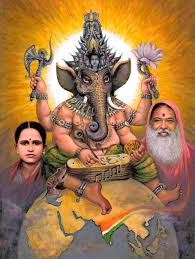Rakṣitā svasya dharmasya svajanasya ca rakṣitā.
Veda vedāṇga tattvajño dhanurvede ca niṣṭhitaḥ.
Meaning- While diligently abiding by His dharma, Rama ensures that all his people are well-protected. He has mastered the in-depth essence of the Vedas and the Vedangas (limbs of Vedas). In addition, he has achieved absolute mastery in archery (dhanurveda).
In this hymn, the traits of a ruler are being highlighted. A king should necessarily abide by the rules and regulations of dharma (righteousness) at all times. Further he should mandatorily ensure protection to all those who have sought shelter under him. More importantly, he should ensure that all his citizens unfailingly abide by dharma.
Being the most supreme and excellent ruler, Rama practised all these above-mentioned traits in totality. He was very conscientious and meticulous in the practice of His own dharma (swadharma).
Dharma differs based on caste (varna) and the stage of life (ashrama). Rama safeguarded the dharmas of all people belonging to the different varnas and ashramas.
When it comes to matters pertaining to dharma, almost everyone is ready to preach. However, when it comes to practical implementation of the same, very few come forward. HOwever, Rama practises the dharma that has been laid down and then He ensures that others around him abide by dharma. This makes Him all the more revered. For this reason, the world quotes Him and states – We should behave like Rama.
Rakshita svasya dharmasya implies Rama protected his bow (dhanus), his horses, chariot, charioteer and His flag. Such a person is titled ‘ati ratha sreshta’. That Rama broke Shiva’s bow is well-known. Defeating Parasurama was yet another extraordinary feat. Through such activities He protected His avatara dharma (dharma of His incarnation).
Svajanasya ca rakshita- protecting citizens is the primary duty of a warrior. True to this rule, Rama zealously protected all his citizens. More importantly He made it His primary duty to protect those who had surrendered and sought refuge in Him.
Veda vedānga tattvajno- Rama has a thorough and in depth knowledge of all the Vedas and the Vedangas. Veda is that which teaches all dharmas in entirety. Vedas are classified into 4 – Rig Veda, Yajur Veda, Saama Veda and Atharvana Veda. Vedangas (limbs of the Vedas) play a very crucial role in helping the person understand the true essence of the Vedas. They are 6 disciplines - Siksha, Kalpa, Vyakarana, Nirukta, Chandas and Jyotisha.
Siksha- this teaches the swaras, phonetics and their positioning, and proper articulation of the Vedic texts. Vyakarana means grammar. It teaches the gentleness (saadhutvam) of the Vedic word. Chandas is the meter (protects the verse through accurate measurement of syllables). Niruktam teaches the etymology of the word. Jyotisha teaches about the karmas that are to be followed as per the dictates of the Vedas. It also teaches the time period for the performance of the karma. Kalpa teaches about the anushthana rituals that should be followed based on the Veda.
Rama was proficient in all this knowledge. He had mastered all the 18 branches of knowledge.
Dhanurvede ca nishtitah- His knowledge in archery was unsurpassed. He possessed the minutest knowledge of wielding the bow. He was adept in the knowledge of fixing the arrow. More importantly, His expertise at releasing the arrow is praiseworthy. Rama’s arrow never misses the target. To a person of the warrior caste (kshyatriya), knowledge of archery is the primary and most important duty.
Upavedas are 4. They are Dhanurveda, Ayurveda, Gandharva Veda and Artha shastra. Through using of the phrase ‘dhanurvede ca nisthitah’ in the last part of the hymn, His expertise in all the 4 upa-vedas has been highlighted.
Om Seeta Raamabhyaam Namaha.
